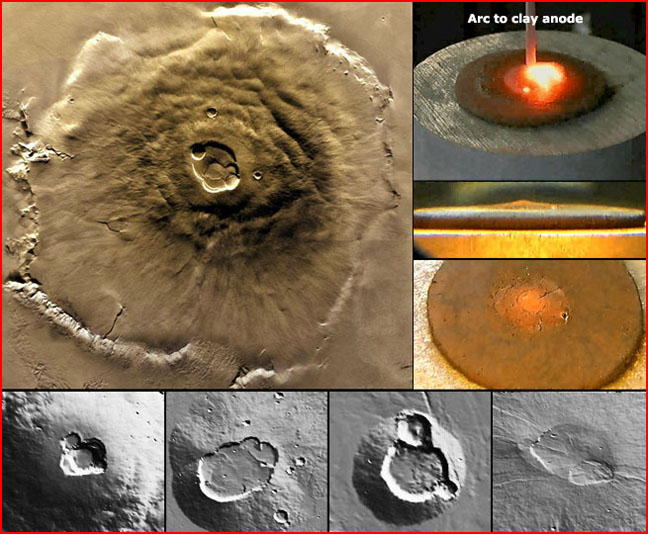|
|
||
 Mars photo credits: MSSS/THEMIS Lab photos on upper right by Wal Thornhill |
||
|
pic of the day Links:
Society for
|
Jul 05, 2004 Olympus Mons on the planet Mars defies categorization as a "volcano," but bears a striking similarity to a lightning blister. Olympus Mons on the planet Mars is taller than three Mount Everests and about as wide as the entire Hawaiian Island chain. But itıs almost as flat as a pancake. Its edge is nearly as abrupt as a pancake, too, ending in a scarp up to 6 kilometers (almost 4 miles) high.
The huge mound rises amidst several lesser Olympus Mons has all the characteristics of a lightning blister. Such raised bell-shaped blisters can be found on the caps of lightning arrestors after a cloud-to-ground strike. They are called "fulgamites". The material that forms the elevated fulgamite is scavenged from the surrounding surface to produce an encircling depression or moat. Olympus Mons has such a moat, which does not match the bulge expected from upwelling magma beneath a volcano. Earthly lightning usually consists of a number of strokes in quick succession along the same ionized path. So the discharge that creates a fulgamite is often followed by successive lesser strokes that may excavate overlapping pits on the top of the fulgamite. The six overlapping circular craters on the summit of Olympus Mons display this pattern. The smaller craters center on the walls of the larger and are cut to different depths, as if with a cookie cutter. Such a pattern is not volcanic, where the caldera floors are supposed to be due to collapse or draining of magma from beneath. A laboratory example of an electric arc scar on a clay anode surface is shown on the right. At moderate power, the electric arc rotates (top right) and raises an extensive circular blister, seen clearly in the middle right image. As the power is increased, the arc briefly stops moving and burns a small circular crater, seen as a glowing spot in the top image and at 4 oıclock in the bottom image. The tendency for the arc to "stick" to one spot on the anode creates localized very high temperatures, sufficient to vaporize some of the anode surface to form smooth circular crater floors and steep terraced walls exactly as seen in the Olympus Mons calderas. Do we see any volcano on Earth produce such a configuration on its summit now? We can find none. Yet the pattern is repeated more than once on the Martian Tharsis Bulge (row of pictures below), including the summit of neighboring Ascraeus Mons (lower left), a striking replica of the Olympus Mons "calderas". The electrical hypothesis maintains that within minutes successive strokes from a cosmic lightning bolt lifted the peak and carved the craters on the summit. It seems likely that the Tharsis Bulge will also trace to the same period of Martian history, when the planet must have engaged another charged body at close range. If so, evidence of such an exchange must be pervasive on the Martian surface, and all the major features of the planet must be reconsidered from this new viewpoint. Though geologists have never entertained the electrical scarring of rocky planets and moons, rapidly accumulating evidence has the potential to change this situation dramatically. |
|
|
Copyright 2004: thunderbolts.info |
||
